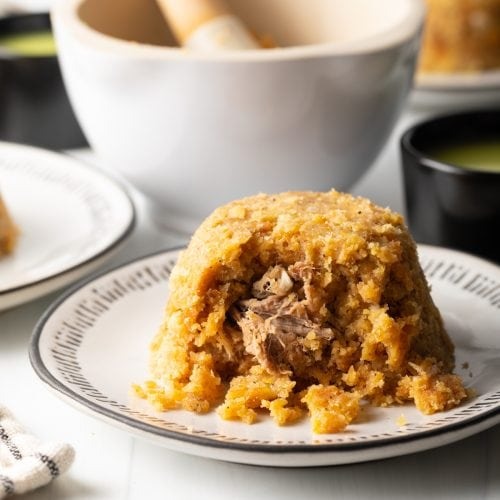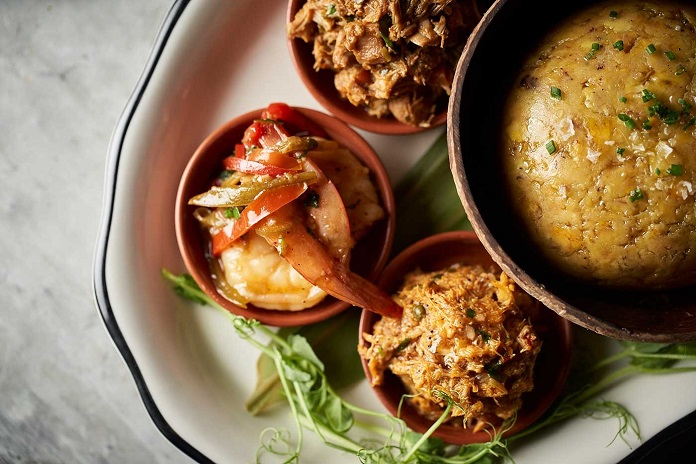On September 24 we celebrate, National Mofongo Day, Mofongo, is a delicious Puerto Rican dish made from mashed plantains, garlic, pork, olive oil, broth, and various seasonings. The fitness is prepared by mashing the plantain in a wooden mortar with a pestle, then adding the spices and liquid elements such as the oil and pork fat to soften the blend. Likewise, In Puerto Rico, mofongo is served either during lunch or dinner or as a side dish with vegetables, chicken, shrimp, beef, or octopus.
History of National Mofongo Day
Did you know that, the origin of mofongo can be traced to the West and Central African fufu? Where, ‘Fufu’ or ‘foofoo’ is a starchy dough-like food made from mashing tubers like yam, cassava, and plantain. Likewise, mofongo is made using a mortar and pestle and served with sauces made with a stew of meat, chicken, fish, or vegetables.
In the year 1500s, this dish was introduced to Puerto Rico by slaves from Angola. The actual name of Mofongo stemmed from an Angolan Kikongo term called ‘mfwenge-mfwenge,’ which means “a great amount of anything.” likewise, the main difference between African fufu and the Puerto Rican mofongo is that mofongo is generally quite dense and thicker than fufu, and it is often served as a main dish whereas fufu’s a side dish with a stew or soup of some sort.
When making fufu the culinarian will use boiled plantain or cassava while when making mofongo the plantain is fried before mashing and mixing it with the other flavours such as olive oil and garlic.
Mofongo has been served on the island for nearly 150 years. It is one dish that blends African and Caribbean flavours uniquely and seamlessly. Besides, this it is so richly flavoured, with textures and vibrant colors.
Also, did you know that chef Jose Mendin felt the dish deserved its holiday? That is why he picked out September 24 because it fell right within Hispanic Heritage Month, and he hoped that the day could be a source of pride for the people of Puerto Rico.

A Spicy Perspective
| 1493 (The Original Mofongo) | During the first Columbus expedition, a cafe serves Puerto Rican dishes that include mofongo. |
| 1500 (Across the Sea) | The Spanish bring slaves from West Africa and among other materials they carry fufu. |
| 1859 (The First Recipe Mention in a Book) | The recipe is titled ‘Mofongo Criollo.’ |
| 2021 (National Mofongo Day Launches) | Jose Mendin requests that the National Day Archives add it to the list of holidays. |
Receip- National Mofongo Day
Ingredients:
- 4 green plantains, peeled and cut into chunks
- 4 cloves garlic, minced
- 1/2 cup pork cracklings (chicharrón), chopped
- 1/4 cup olive oil
- Salt and pepper, to taste
- Chicken or beef broth (optional, for added moisture)
- Fresh cilantro (optional, for garnish)
How to make
- In a large pot, bring water to a boil and add a pinch of salt.
- Add plantain chunks and cook until tender, about 10-15 minutes.
- Drain and set aside.
- In a large bowl or mortar and pestle, combine the cooked plantains, minced garlic, and pork cracklings.
- Mash together until you get a chunky, somewhat smooth consistency. If using a bowl, you can use a potato masher or fork.
- Add olive oil, and mix well. Season with salt and pepper to taste.
- If the mixture seems too dry, add a little chicken or beef broth to achieve your desired consistency.
- Form the mofongo into small balls or serve in a mound on a plate.
- Garnish with fresh cilantro if desired.
- Serve with your choice of filling, such as sautéed shrimp, pork, or chicken.
Extra Tips
– For a Vegetarian Version:
- Substitute pork cracklings with crispy onions or mushrooms. Use vegetable broth instead of chicken broth.
– Adding Flavor:
- Mix in some sautéed onions, peppers, or tomatoes for additional flavour.
– Making Mofongo Relleno:
- You can stuff mofongo with meats or seafood before serving. Simply mould the mofongo around your filling of choice, then cook or bake until heated through.
– For Extra Crispiness:
- If you prefer a slightly crispy texture, you can pan-fry the mashed mofongo in a skillet with a little oil until the outside is crispy.
– Using a Mortar and Pestle:
- Traditional mofongo is made using a mortar and pestle, which helps to achieve the desired texture. If you don’t have one, a large bowl and potato masher will work fine.
Conclusion
FAQs
Can mofongo be made vegetarian?
Yes, You can make vegetarian mofongo by omitting pork cracklings and adding vegetables or mushrooms instead.
What are common fillings for mofongo?
Common fillings include shrimp, pork, chicken, and beef. Some variations also use seafood or even vegetarian options like sautéed vegetables.
How do you make mofongo?
Peel and cut plantains into chunks, then boil or fry them until tender. Mash the plantains with garlic and pork cracklings, season with salt and pepper, and mix well. Shape into balls or a mound, and serve with your choice of protein.
What is mofongo?
Mofongo is a traditional Puerto Rican dish made from green plantains that are fried, mashed, and mixed with garlic, pork cracklings (chicharrón), and seasonings.
Can I use ripe plantains for mofongo?
Traditionally, mofongo is made with green plantains because they have a firmer texture that holds up well when mashed. Ripe plantains are sweeter and softer, which makes them less ideal for this dish.
What is the difference between mofongo and tostones?
Mofongo is made from mashed plantains mixed with garlic, pork cracklings, and seasonings.
Tostones are twice-fried green plantain slices, which are crispy and often served as a snack or side dish.
Also, read more about National Double Cheeseburger Day – September 15, 2024
